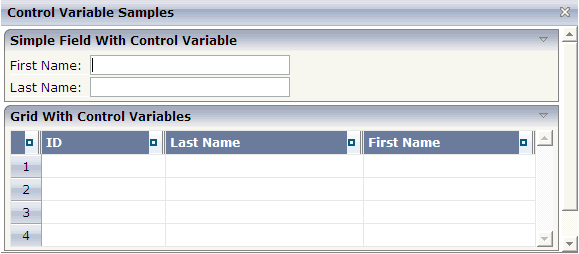With an XCIDATADEF control, you can define data structures that are exchanged between a page and its adapter, but which are not visually represented on the page. Examples are Natural control variables, which can be assigned to controls on a page after they have been defined in an XCIDATADEF control. They are not visually represented on the page, but can be evaluated by the application to control the modification status of the page and its controls.
The XCIDATADEF control allows the definition of scalar variables, structures, arrays, structures of arrays and arrays of structures. When an adapter is generated from a page that contains one or more XCIDATADEF controls, corresponding Natural data structures are generated into the parameter data area of the adapter.
The following topics are covered below:
The following example shows several field controls and a grid control. It uses XCIDATADEF controls to define control variables and assigns these in various ways to the fields and grid elements of the page.

The XML layout definition is:
<?xml version="1.0" encoding="UTF-8"?>
<natpage hotkeys="13;onEnter" natsource="CTRCV-A" natsinglebyte="true" natcv="cv-page"
xmlns:njx="http://www.softwareag.com/njx/njxMapConverter">
<titlebar name="Control Variable Samples">
</titlebar>
<pagebody takefullheight="true">
<rowarea name="Simple Field With Control Variable">
<itr>
<label name="First Name:" width="80">
</label>
<field valueprop="firstname" width="200" njx:natcv="cv-firstname">
</field>
<hdist width="50">
</hdist>
</itr>
<itr>
<label name="Last Name:" width="80">
</label>
<field valueprop="lastname" width="200" njx:natcv="cv-lastname">
</field>
</itr>
</rowarea>
<rowarea name="Grid With Control Variables">
<rowtablearea2 griddataprop="persons" rowcount="4" width="100%">
<tr>
<gridcolheader width="30" propref="selected">
</gridcolheader>
<gridcolheader name="ID" width="25%" propref="id">
</gridcolheader>
<gridcolheader name="Last Name" width="40%" propref="last">
</gridcolheader>
<gridcolheader name="First Name" width="35%" propref="first">
</gridcolheader>
</tr>
<repeat>
<str valueprop="selected">
<selector valueprop="selected" singleselect="true">
</selector>
<field valueprop="id" width="25%" noborder="true"
transparentbackground="true">
</field>
<field valueprop="last" width="40%" noborder="true"
transparentbackground="true" njx:natcv="persons(*).cv-last">
</field>
<xcidatadef dataprop="cv-last" datatype="C">
</xcidatadef>
<field valueprop="first" width="35%" noborder="true"
transparentbackground="true" njx:natcv="cv-first(*)">
</field>
</str>
</repeat>
</rowtablearea2>
</rowarea>
<rowarea name="Description" height="100%">
<itr takefullwidth="true" height="100%">
<subpage valueprop="infopagename" height="100%" width="100%">
</subpage>
</itr>
</rowarea>
</pagebody>
<statusbar withdistance="false">
</statusbar>
<xcidatadef dataprop="cv-page" datatype="C">
</xcidatadef>
<xcidatadef dataprop="cv-firstname" datatype="C">
</xcidatadef>
<xcidatadef dataprop="cv-lastname" datatype="C">
</xcidatadef>
<xcidatadef dataprop="cv-first" datatype="C" array="true">
</xcidatadef>
</natpage>
The above example shows various ways in which control variables can be defined and assigned to controls:
cv-page is a scalar control variable that is assigned to
the page as a whole. In the application, it reflects the modification status of
the entire page.
cv-firstname and cv-lastname are scalar
control variables that are assigned to the FIELD controls
firstname and lastname. They reflect the modification
status of the respective controls.
cv-last is a control variable that is defined as an
element of the grid persons. Consequently, it is implicitly an
array and is assigned to the element last as
persons(*).cv-last. Each occurrence of
persons(*).cv-last reflects the modification status of the
corresponding occurrence of persons.last.
cv-first is an array of control variables that is defined
outside the grid persons. Consequently, it is assigned to the
element first as cv-first(*). Each occurrence of
cv-first(*) reflects the modification status of the corresponding
occurrence of persons.first. Note the difference to the previous
case: because cv-first(*) is defined outside the grid
persons, it is not automatically resized together with
persons.first. Resizing cv-first(*) appropriately is
in the responsibility of the application program.
The corresponding adapter code looks as follows:
DEFINE DATA PARAMETER /*( PARAMETER 1 CV-FIRST (C/1:*) 1 CV-FIRSTNAME (C) 1 CV-LASTNAME (C) 1 CV-PAGE (C) 1 FIRSTNAME (A) DYNAMIC 1 INFOPAGENAME (A) DYNAMIC 1 LASTNAME (A) DYNAMIC 1 PERSONS (1:*) 2 CV-LAST (C) 2 FIRST (A) DYNAMIC 2 ID (A) DYNAMIC 2 LAST (A) DYNAMIC 2 SELECTED (L) /*) END-PARAMETER END-DEFINE ... /*( PROCESS PAGE PROCESS PAGE (CV=CV-PAGE) U'/njxdemos/ctrlcontrolvar' WITH PARAMETERS NAME U'firstname' VALUE FIRSTNAME (CV=CV-FIRSTNAME) NAME U'infopagename' VALUE INFOPAGENAME NAME U'lastname' VALUE LASTNAME (CV=CV-LASTNAME) NAME U'persons(*).first' VALUE PERSONS.FIRST(*) (CV=CV-FIRST(*)) NAME U'persons(*).id' VALUE PERSONS.ID(*) NAME U'persons(*).last' VALUE PERSONS.LAST(*) (CV=PERSONS.CV-LAST(*)) NAME U'persons(*).selected' VALUE PERSONS.SELECTED(*) (EM='false'/'true') END-PARAMETERS /*) END-PROCESS ...
The example code is contained in the library SYSEXNJX as
program CTRCV-P.
| Basic | |||
| dataprop |
The XCIDATADEF control allows to create data structures for the processing side that are created in addition to data structures that are created by the normal controls. The DATAPROP represents the name of the data element that provides the content of the control. |
Optional | |
| datatype |
Data type of the data element. One of the list of valid values. Using the reserved word "type" you can nest multiple XCIDATADEF structures. |
Optional |
type xs:string xs:int xs:float xs:decimal xs:double xs:date xs:dateTime xs:time xs:byte xs:short ------------------------ N n.n P n.n string n C |
| array |
If set to true, the XCIDATADEF will be an array. |
Optional |
true false |